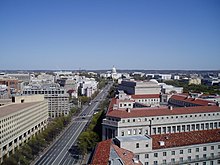Pennsylvania Avenue
The Pennsylvania Avenue is next to the Mall , the most famous street in Washington, DC , the capital of the United States . Part of Pennsylvania Avenue has been a National Historic Site since 1966 .
The street network of the city, planned by the French architect Pierre L'Enfant, consists, as in most North American cities, of a regular, rectangular grid. In Washington, however, this is overlaid by large diagonals. These diagonal axes are almost exclusively named after the states of the USA.
Pennsylvania Avenue runs largely in a straight line through the city for around 11 kilometers. It begins in the northwest ( Georgetown ) at the bridge over Rock Creek , runs over Washington Circus to the White House , from there to the Capitol , crosses the Anacostia River by means of the John Philipp Sousa Memorial Bridge and after a few kilometers reaches the city limits of the state of Maryland .
The street connects the two most important government buildings in the USA, the White House as the seat of the US President and the Capitol as the seat of the two Houses of Parliament ( Congress of the United States ), both of which are in the middle of the line of sight. Between these two symbols for the constitutional powers, executive and legislative, there are numerous other government buildings along the street. Especially the section from 6th to 15th Street, where the street represents the northern border of the Federal Triangle , is lined with such.
The White House is number 1600. The address 1600 Pennsylvania Avenue is also used as a metonym for the White House, similar to the address No. Downing Street. 10 for the seat of the British Prime Minister, Quai d'Orsay for the French Foreign Ministry or Wilhelmstrasse for the governments of the German Reich until 1945. The White House stands at the intersection of the axes of Pennsylvania and New York Avenue.
On September 30, 1965, part of Pennsylvania Avenue was declared a National Historic Site . On October 15, 1966, the Pennsylvania Avenue National Historic Site was added to the National Register of Historic Places .
The street was one of the first thoroughfares in the city. Many official parades and countless protest parades are held along this street every year. B. on March 24, 2018 the main national event of the March for Our Lives .
After the 1995 bombing of the Murrah Federal Building in Oklahoma City , parts of the road near the White House were closed to traffic, and the blockage became permanent after the September 11, 2001 terrorist attacks .
Web links
Individual evidence
- ^ National Park Service : The National Parks: Index 2009–2011 . United States Department of the Interior, ISBN 978-0-912627-81-6 , p. 36.
- ^ Pennsylvania Avenue National Historic Site on the National Register Information System. National Park Service , accessed August 3, 2017.
Coordinates: 38 ° 53 '38.4 " N , 77 ° 1' 26" W.
